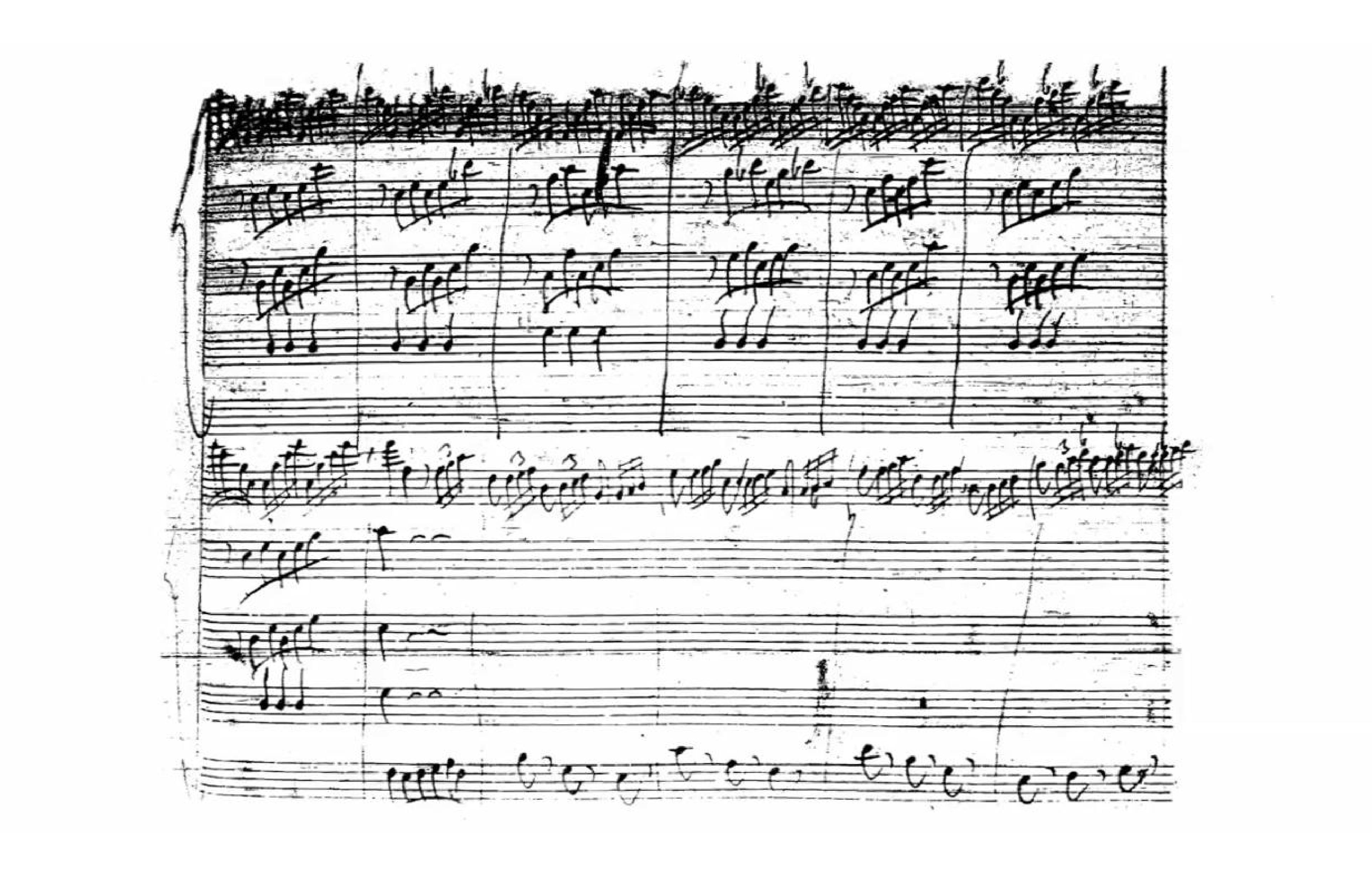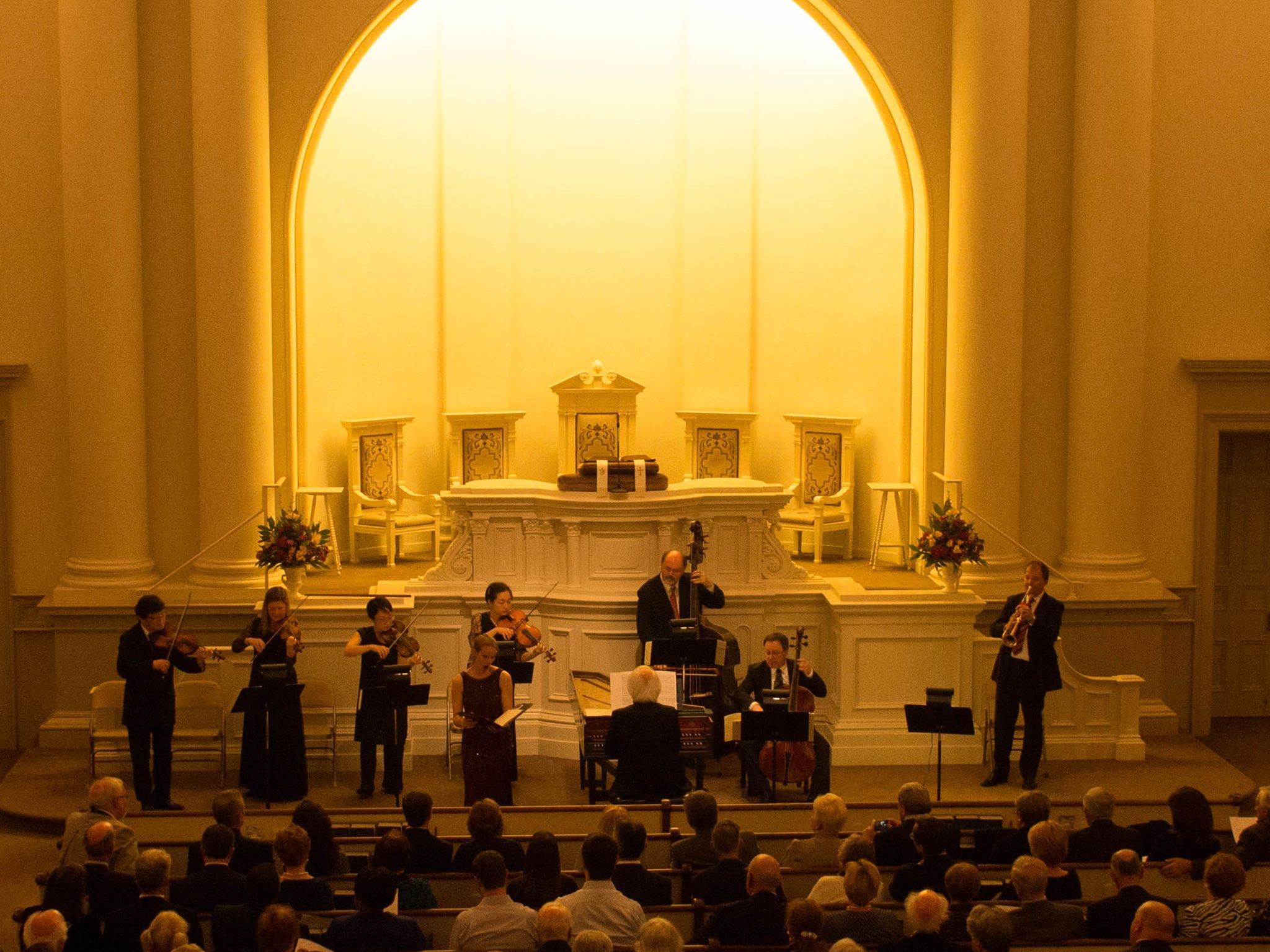
Above is the Bach Collegium Japan, following their performance of Bach’s Second Brandenburg Concerto. If you look to the far right, you’ll see their trumpeter, Guy Ferber, holding what I thought looked like a Christmas tree ornament. In fact, it’s a coiled natural trumpet, which Guy played to amazing affect. I’ve never heard one in person, and when I saw him take the stage, I began to worry – they’re fiendishly difficult to play, and most fans of early music sort of accept that the accuracy to which we’re accustomed on modern instruments is a bit of a moving target for players of their forbearers, one of whom is represented below, holding a coiled instrument. The portrait is actually Haussmann’s famous portrait of Gottfried Reiche, Bach’s trumpeter.

If Reiche’s abilities were renowned in Bach’s time, then Guy’s amazing playing should surely be equally famous in ours. In fact, Greg Funfgeld approached Guy after the concert and said, “You’re our Reiche!” Guy demurred, but there was much admiration for his playing, both on the Brandenburg, and the thrilling obbligato in Cantata 51, Jauchzet Gott in allen Landen. The man has nerves of steel, and his accuracy, particularly on such a challenging instrument, was more than admirable. The Brandenburgs are actually a collection of concerti grossi, and the second includes a quartet of soloists: trumpet, oboe, recorder, and violin. The contributions from Guy’s colleagues – Masamitsu San’nomiya on oboe, Andreas Böhlen on recorder, and Ryo Terakado on violin – were equally thrilling. It was also interesting to hear the trumpet at a level of dynamism that complimented the other instruments. One is usually accustomed to hearing the trumpet as a kind of first, even among equals. In this performance, the most egalitarian Second Brandenburg I’ve ever heard, the dialogues between the instruments had far greater clarity than is usual, and I was grateful to hear the lines of counterpoint rendered with such proportionality. The performance also put the audience on warning – we were in for a spectacular night of music making.
Andreas Böhlen’s performance of Vivaldi’s Concerto in C Major, RV 443 for recorder followed the Bach, and so dexterous, so exciting was his playing, that the audience was soon on its feet at the conclusion. If you take a gander at Vivaldi’s manuscript below, you can see why:

The solo part (the top line) is extremely fierce, and Andreas pulled it off with a thrilling combination of lightning speed and stunning musicality. He had excellent support from his colleagues in the BCJ – they played with fire appropriate to the Red Priest’s zesty music.
At this point, I was wondering how the concert could get any better, and then the stellar British soprano, Joanne Lunn, took the stage to offer Händel’s recently-discovered Gloria in B-flat Major. I can no longer claim any objectivity about Ms. Lunn – I have long admired her on recording, and was rapt to hear her live. On recordings, sight unseen, she conveys a rare warmth in this repertoire, and, in person, she was radiant. Her declamation of text, in Latin or German, demonstrates a keen understanding of not just the principles of diction, but how excellent diction can convey a depth of meaning when employed with great artistry. Her handling of the melismatic passages and coloratura elements in the Händel (pun only partly intended) was impeccable, but the joy and warmth of her singing in person took things even further over the top. Brava!

(Confession: I encountered Joanne after the concert, on my way to have a few words with our fearless leader. I fairly stammered some praise, and she was exceedingly gracious and kind, and full of the warmth that is her musical trademark. I hope we can have her back to Bethlehem again!)
I had the opportunity to visit with several colleagues and friends during intermission, and the consensus was one of near-disbelief. The instrumental ensemble was made up of one player on a part, but the gut strings under less tension than modern instruments made for a slightly more quiet, but very rich, sound. The artistry I alluded to in my preview for the performance was on great display, and watching the blistering technique, and hearing the stunning array of colors was quite a treat.
The second half of the concert began in a more introspective tone, but the change of energy was most welcome. Kiyomi Suga offered Bach’s Flute Sonata in E Minor, BWV 1034, with Maestro Suzuki at the harpsichord, and the wonderful Emmanuel Balssa offering continuo support from his beautiful ‘cello. The color of a baroque flauto traverso has a slightly breathy quality, and there’s a remarkable (and to my ear) extremely desirable rusticity in the varieties in the onset of the instrument’s sound. Ms. Suga’s playing had such intellectual and spiritual depth in the slower movements, and she was admirably dexterous in the quicker stuff. The reduced orchestration gave the audience and some of the players a breather, and we were wowed by Kiyomi’s consummate artistry.
The concert began building to the fireworks of its closing with another Vivaldi Concerto, this time featuring Masamitsu San’nomiya’s glorious playing on the Concerto in C Major, RV 450. Gone are the quacky baroque oboes from the early days of the period instruments movement (and God bless those pioneers!). Masamitsu’s total mastery of the instrument fuses the accuracy of modern instruments players with the color and quirks of the baroque instrument. Again with the amazing dexterity, again with the humbling musicality. The performance was a tour-de-force.
Who wouldn’t want to hear Joanne Lunn and Guy Ferber play musical tag (as someone brilliantly wrote in our promotions for this concert) in Bach’s virtuosic cantata, Jauchzet Gott in allen Landen, BWV 51? Theirs was (again) a thrilling performance – melismatic bliss, deep devotion, a race to the rhapsodic top Cs, etc! Joanne’s Höchster, mache deine Güte, the third movement, was full of passion and impossibly elegant phrasing. The duetting violins of Ryo Terakado and Cynthia Roberts in the fourth movement provided a rock-solid foundation for Joanne’s pitch-perfect floating of the doxological cantus firmus, and then the whole ensemble launched into overdrive with the precision and euphoric woosh of an Italian sports car. I was particularly delighted to have a sense of both the arch intricacy and the dramatic sweep of this movement. And the joy, which cannot be overstated. We were treated to the wonderful concluding movement of Cantata 199, a sprightly and succinct aria, to allow us a few moments of afterglow, as an encore.
I have thus far mentioned everyone in the ensemble except the violinist, Yuki Yamaguchi, the violist, Mika Akiha, and the bassist, Frank Coppieters, because they didn’t have any solos. What they did offer, however, was achingly beautiful and archly competent playing on everything in the program that required them. The flawless intonation, the sympathetic phrasing, and the sheer artistry of their work was greatly admired and appreciated.
Finally, a few words about Masaaki Suzuki, one of my musical heroes, and the leader of this intrepid ensemble. He is one of our most cerebral and spiritually and intellectually accomplished Bach interpreters, and one of our rare practitioners who combines thorough scholarship with total musical mastery. One might expect that this would make for a serious or grave package, and yet, Suzuki’s is a quiet, charming, and whimsical presence. In the performances, he led with small gestures, a sympathetic breath, or a nod, and was eager to hand the spotlight to his immensely talented colleagues. But, make no mistake, the animating spark of the musical pyrotechnics of this performance comes clearly from this learned and richly accomplished man. Many thanks to our friends from the Bach Collegium Japan for a night of inspiration and joy.
I understand that the swanky party that followed was a grand success, and I’m guessing that we hit all of our goals for attendance and tickets sold – there was a pretty full house. We sat near some high school students who were able to see some of the rehearsal (and who had rehearsed earlier, themselves, for their participation in our Family Concert, which will be a festival of youth choirs, of sorts), and it was edifying to see their delight at these reference performances of this music. In a sense, we’re doing all this for them – the Gala benefits our ambitious educational outreach program, of which they’re a big part!

Next up: Bach at Noon, this coming Tuesday, November 10th, also at Central Moravian Church. On tap: the Bach Choir premiere of Bach’s Flute Sonata in A Major, BWV 1032, featuring our own accomplished Kapellemeister, Greg Funfgeld, and the always-wonderful Robin Kani on flute. The choral selection will be Bach’s exuberant cantata, Es ist dir gesacht, BWV 45, in a reprise from The Choir’s Bach at 4 performance at the Festival, this past May. I won’t be singing, but I know that the singers’ mastery of this piece is hard-won. It’s a thrill to hear, and quite nettlesome to sing. They worked really hard to master it, and sounded in especially fine form at our last rehearsal. As always, plan to arrive early to ensure a good seat. The doors will open at 11:30 am.










































